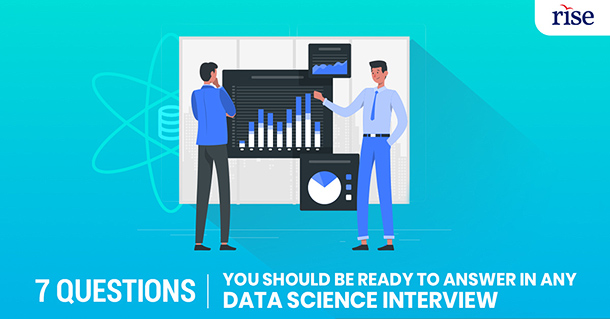With ongoing innovations in Big Data & Machine Learning’s dynamic world, data scientists have emerged as a new breed of specialists. They have the technical know-how to solve complex problems and the inquisitiveness to identify them even before they crop up.
But due to the shortage of skilled resourced and hard-to-find multi-factors, the demand for versatile data scientists is at an all-time high. And so is the competition! To help you prep for your in-person interview, we’ve put together 7 decisive data science interview questions and answers.
Read on to know what you can expect and ace your test,
1. What is the Difference between Supervised & Unsupervised Learning?
| Supervised Learning |
Unsupervised Learning |
| Only known & labelled data can be used as input |
Unlabelled data can be used as input |
| Integrates a feedback mechanism |
No feedback mechanism |
| The most preferred algorithms are support vector machine, decision trees & logistic regression |
The most popular learning algorithms are apriori algorithms, hierarchical clustering & k-means clustering. |
2. How Do You Develop a Random Forest Model?
A random forest is made up of several decision trees. Suppose you divide this data into different packages and make one decision tree for every group. In that case, the random forest will bring all the trees from other data groups together.
The steps to create a random forest model are as follows:
- Randomly pick ‘k’ features from all the ‘m’ features where k
- Use the best split point to calculate the node D from among the ‘k’ features
- Split the node further into daughter nodes
- Repeat steps 2 & 3 until you have finalized all the leaf nodes
- Build the forest model by repeating the first 4 steps ‘n’ number of times to create ‘n’ number of trees
3. What is Selection Bias?
Selection bias is an error associated with research studies where the participants are not randomly selected. When the researcher determines the subjects, the results of the statistical analysis are distorted. Due to this, the results may not be accurate. The different types of selection bias include:
- Attrition – caused by loss of participants
- Sampling bias – a systematic error resulting from a non-random study sample
- Data – occurs when specific data subsets are selected to substantiate a conclusion or rejection
- Time interval – caused by a trial that is terminated before the time at an extreme value due to ethical reasons
4. What is Logistic Regression?
Logistic regression is typically used to predict the binary result of a linear combination of different predictor variables. For instance. If you want to forecast the results of an election campaign, the outcome is either 0 or 1 (win/lose). The variables used in this case would be the amount of time spent on campaigning and the funds used for the same.
5. What is Deep Learning?
It is a sub-discipline of machine learning that draws inspiration from the brain’s neural network structure and functioning. While machine learning comprises many algorithms like SVM, linear regression, neural networks, deep learning is just an extended form of neural networks. Deep learning algorithms have a vast number of hidden layers instead of the small number of hidden layers in neural nets. These hidden layers make it complex to understand the relationship between input and output.
6. Explain TF-IDF Vectorization?
TF-IDF stands for term frequency-inverse document frequency. It is typically used as a weighing component in text mining and data retrieval. The increase in tf-idf value is directly proportional to the number of times a specific word appears in a given document. However, it is offset by the total frequency of the terms used in the body copy.
7. List the Feature Selection Methods for Selecting the Right Variables
The two main methods that are widely used for feature selection include filter and wrapper methods.
Filter Methods
- Chi-Square
- ANOVA
- Linear discrimination analysis
The right analogy for choosing features is “bad data in, bad response out.” When you’re selecting the elements, it’s all about clearing up the data that’s flowing in.
Wrapper Methods
- Forward Selection: For testing one feature at a time until you arrive at a good fit
- Backward Selection: For testing several features and eliminating some to keep only the ones that work best
- Recursive Feature Elimination: Recursively scans all the features and how they complement each other
Wrapper methods are time-consuming and require sophisticated computers for performing data analysis.
And with this, we sum up answers for the top data science interview questions. But if you want to fully prepare yourself for one of the most in-demand technology frontiers, check out this hands-on data analytics course offered by LearnAtRise.
You can upgrade your skillset with this practically-driven and career-oriented training program that offers hands-on training by industry experts. It will familiarize you with all the data science interview questions for freshers and equip you with soft skills and tool-based technical knowledge to prepare you for the professional world.

